Risk Assessment of Flood Disasters with Multi-Source Data and Its Spatial Differentiation Characteristics
Abstract
1. Introduction
2. Study Area
3. Materials and Methods
3.1. Data Source
3.2. Analysis of Risk Indicators
3.3. Research Method
3.3.1. Research Framework
3.3.2. Data Standardization
3.3.3. Analytic Hierarchy Process
3.3.4. Entropy Weight Method
3.3.5. Combination Method
3.4. Spatial Analysis
3.4.1. Global Spatial Autocorrelation Analysis
3.4.2. Local Spatial Autocorrelation Analysis
4. Results
4.1. Results of Risk Analysis
4.2. Result Verification
4.3. Global Spatial Analysis Results
4.4. Results of Local Spatial Analysis
4.4.1. Clustering and Outlier Analysis
4.4.2. Hot Spot Analysis
5. Discussion
6. Conclusions
Author Contributions
Funding
Data Availability Statement
Acknowledgments
Conflicts of Interest
References
- Kreibich, H.; Van Loon, A.F.; Schröter, K.; Ward, P.J.; Mazzoleni, M.; Sairam, N.; Abeshu, G.W.; Agafonova, S.; AghaKouchak, A.; Aksoy, H.; et al. The challenge of unprecedented floods and droughts in risk management. Nature 2022, 608, 80. [Google Scholar] [CrossRef]
- Wu, H.L.; Cheng, W.C.; Shen, S.L.; Lin, M.Y.; Arulrajah, A. Variation of hydro-environment during past four decades with underground sponge city planning to control flash floods in Wuhan, China: An overview. Undergr. Space 2020, 5, 184–198. [Google Scholar] [CrossRef]
- Wang, X.J.; Xia, J.Q.; Dong, B.L.; Li, Q.J.; Zhang, X. Hydrodynamics-based assessment of flood losses in an urban district under changing environments. Nat. Hazards 2024, 120, 14755–14783. [Google Scholar] [CrossRef]
- Diakakis, M.; Mavroulis, S.; Deligiannakis, G. Floods in Greece, a statistical and spatial approach. Nat. Hazards 2012, 62, 485–500. [Google Scholar] [CrossRef]
- Zhao, Y.; Gong, Z.W.; Wang, W.H.; Luo, K. The comprehensive risk evaluation on rainstorm and flood disaster losses in China mainland from 2004 to 2009: Based on the triangular gray correlation theory. Nat. Hazards 2014, 71, 1001–1016. [Google Scholar] [CrossRef]
- Newman, J.P.; Maier, H.R.; Riddell, G.A.; Zecchin, A.C.; Daniell, J.E.; Schaefer, A.M.; van Delden, H.; Khazai, B.; O’Flaherty, M.J.; Newland, C.P. Review of literature on decision support systems for natural hazard risk reduction: Current status and future research directions. Environ. Modell. Softw. 2017, 96, 378–409. [Google Scholar] [CrossRef]
- Gigovic, L.; Pamucar, D.; Bajic, Z.; Drobnjak, S. Application of GIS-Interval Rough AHP Methodology for Flood Hazard Mapping in Urban Areas. Water 2017, 9, 360. [Google Scholar] [CrossRef]
- Lyu, H.M.; Shen, S.L.; Zhou, A.N.; Zhou, W.H. Flood risk assessment of metro systems in a subsiding environment using the interval FAHP-FCA approach. Sustain. Cities Soc. 2019, 50, 101682. [Google Scholar] [CrossRef]
- Bhere, S.; Reddy, M.J. Flood risk assessment of suburban region in India by incorporating flood hazard, vulnerability and exposure. Nat. Hazards 2024, 121, 6625–6649. [Google Scholar] [CrossRef]
- Yin, Z.E.; Yin, J.; Xu, S.Y.; Wen, J.H. Community-based scenario modelling and disaster risk assessment of urban rainstorm waterlogging. J. Geogr. Sci. 2011, 21, 274–284. [Google Scholar] [CrossRef]
- Lin, T.; Liu, X.F.; Song, J.C.; Zhang, G.Q.; Jia, Y.Q.; Tu, Z.Z.; Zheng, Z.H.; Liu, C.L. Urban waterlogging risk assessment based on internet open data: A case study in China. Habitat. Int. 2018, 71, 88–96. [Google Scholar] [CrossRef]
- Wu, Z.N.; Shen, Y.X.; Wang, H.L. Assessing Urban Areas’ Vulnerability to Flood Disaster Based on Text Data: A Case Study in Zhengzhou City. Sustainability 2019, 11, 4548. [Google Scholar] [CrossRef]
- Xiao, Y.F.; Yi, S.Z.; Tang, Z.Q. Integrated flood hazard assessment based on spatial ordered weighted averaging method considering spatial heterogeneity of risk preference. Sci. Total Environ. 2017, 599, 1034–1046. [Google Scholar] [CrossRef] [PubMed]
- Prall, M.C.; Brandt, U.S.; Halvorsen, N.S.; Hansen, M.U.; Dahlberg, N.; Andersen, K.J. A comprehensive approach for assessing social flood vulnerability and social flood risk: The case of Denmark. Int. J. Disaster Risk Reduct. 2024, 111, 104686. [Google Scholar] [CrossRef]
- Du, W.Y.; Gong, Y.; Chen, N.C. PSO-WELLSVM: An integrated method and its application in urban waterlogging susceptibility assessment in the central Wuhan, China. Comput. Geosci. 2022, 161, 105079. [Google Scholar] [CrossRef]
- Wu, Y.N.; Zhong, P.A.; Xu, B.; Zhu, F.L.; Ma, B. Changing of flood risk due to climate and development in Huaihe River basin, China. Stoch. Environ. Res. Risk A 2017, 31, 935–948. [Google Scholar] [CrossRef]
- Cai, S.Y.; Fan, J.M.; Yang, W. Flooding Risk Assessment and Analysis Based on GIS and the TFN-AHP Method: A Case Study of Chongqing, China. Atmosphere 2021, 12, 623. [Google Scholar] [CrossRef]
- Gao, L.; Liu, X.X.; Liu, H. Spatiotemporal differentiation characteristics of flood risk based on spatial statistical analysis: A study of Jing-Jin-Ji region in China. Nat. Hazards 2025, 121, 1711–1736. [Google Scholar] [CrossRef]
- Zhang, Q.F.; Wu, Z.F.; Zhang, H.; Dalla Fontana, G.; Tarolli, P. Identifying dominant factors of waterlogging events in metropolitan coastal cities: The case study of Guangzhou, China. J. Environ. Manag. 2020, 271, 110951. [Google Scholar] [CrossRef]
- Wang, X.; Xia, J.; Zhou, M.; Deng, S.; Li, Q. Assessment of the joint impact of rainfall and river water level on urban flooding in Wuhan City, China. J. Hydrol. 2022, 613, 128419. [Google Scholar] [CrossRef]
- Xiao, S.; Zou, L.; Xia, J.; Dong, Y.; Yang, Z.Z.; Yao, T.C. Assessment of the urban waterlogging resilience and identification of its driving factors: A case study of Wuhan City, China. Sci. Total Environ. 2023, 866, 161321. [Google Scholar] [CrossRef]
- Liu, J.; Wang, S.Y.; Li, D.M. The Analysis of the Impact of Land-Use Changes on Flood Exposure of Wuhan in Yangtze River Basin, China. Water Resour. Manag. 2014, 28, 2507–2522. [Google Scholar] [CrossRef]
- Lyu, H.M.; Sun, W.J.; Shen, S.L.; Arulrajah, A. Flood risk assessment in metro systems of mega-cities using a GIS-based modeling approach. Sci. Total Environ. 2018, 626, 1012–1025. [Google Scholar] [CrossRef] [PubMed]
- Choubin, B.; Moradi, E.; Golshan, M.; Adamowski, J.; Sajedi-Hosseini, F.; Mosavi, A. An ensemble prediction of flood susceptibility using multivariate discriminant analysis, classification and regression trees, and support vector machines. Sci. Total Environ. 2019, 651, 2087–2096. [Google Scholar] [CrossRef] [PubMed]
- Chen, P.; Chen, X.L. Spatio-temporal variation of flood vulnerability at the Poyang Lake Ecological Economic Zone, Jiangxi Province, China. Water Sci. Technol. 2012, 65, 1332–1340. [Google Scholar] [CrossRef]
- Tanoue, M.; Hirabayashi, Y.; Ikeuchi, H. Global-scale river flood vulnerability in the last 50 years. Sci. Rep. 2016, 6, 36021. [Google Scholar] [CrossRef]
- Borowska-Stefanska, M. Conceptual Framework for Flood Vulnerability Assessment. Nat. Hazards Rev. 2024, 25, 05024003. [Google Scholar] [CrossRef]
- Xu, H.S.; Ma, C.; Lian, J.J.; Xu, K.; Chaima, E. Urban flooding risk assessment based on an integrated k-means cluster algorithm and improved entropy weight method in the region of Haikou, China. J. Hydrol. 2018, 563, 975–986. [Google Scholar] [CrossRef]
- Fang, J.; Hu, J.M.; Shi, X.W.; Zhao, L. Assessing disaster impacts and response using social media data in China: A case study of 2016 Wuhan rainstorm. Int. J. Disaster Risk Reduct. 2019, 34, 275–282. [Google Scholar] [CrossRef]
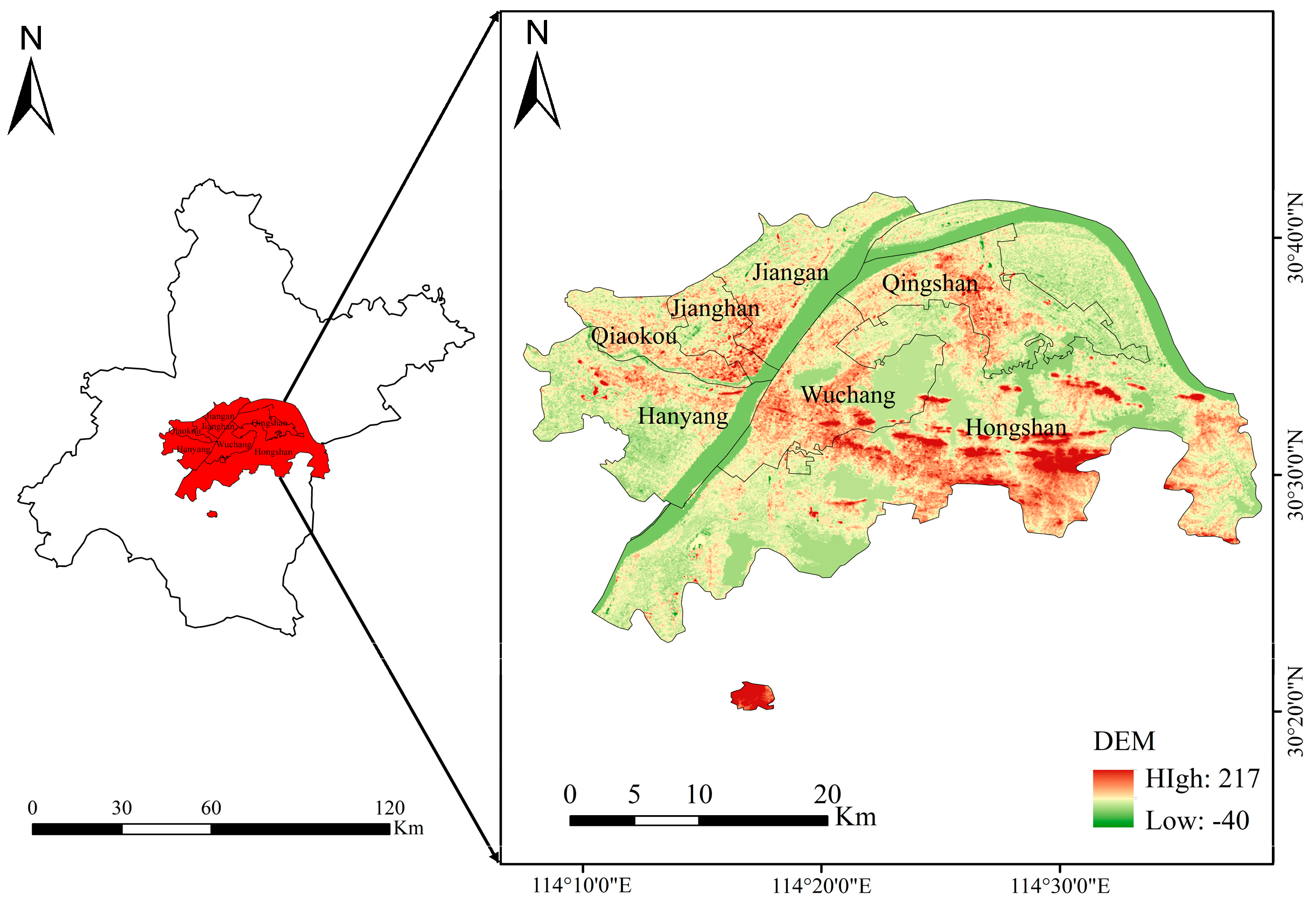
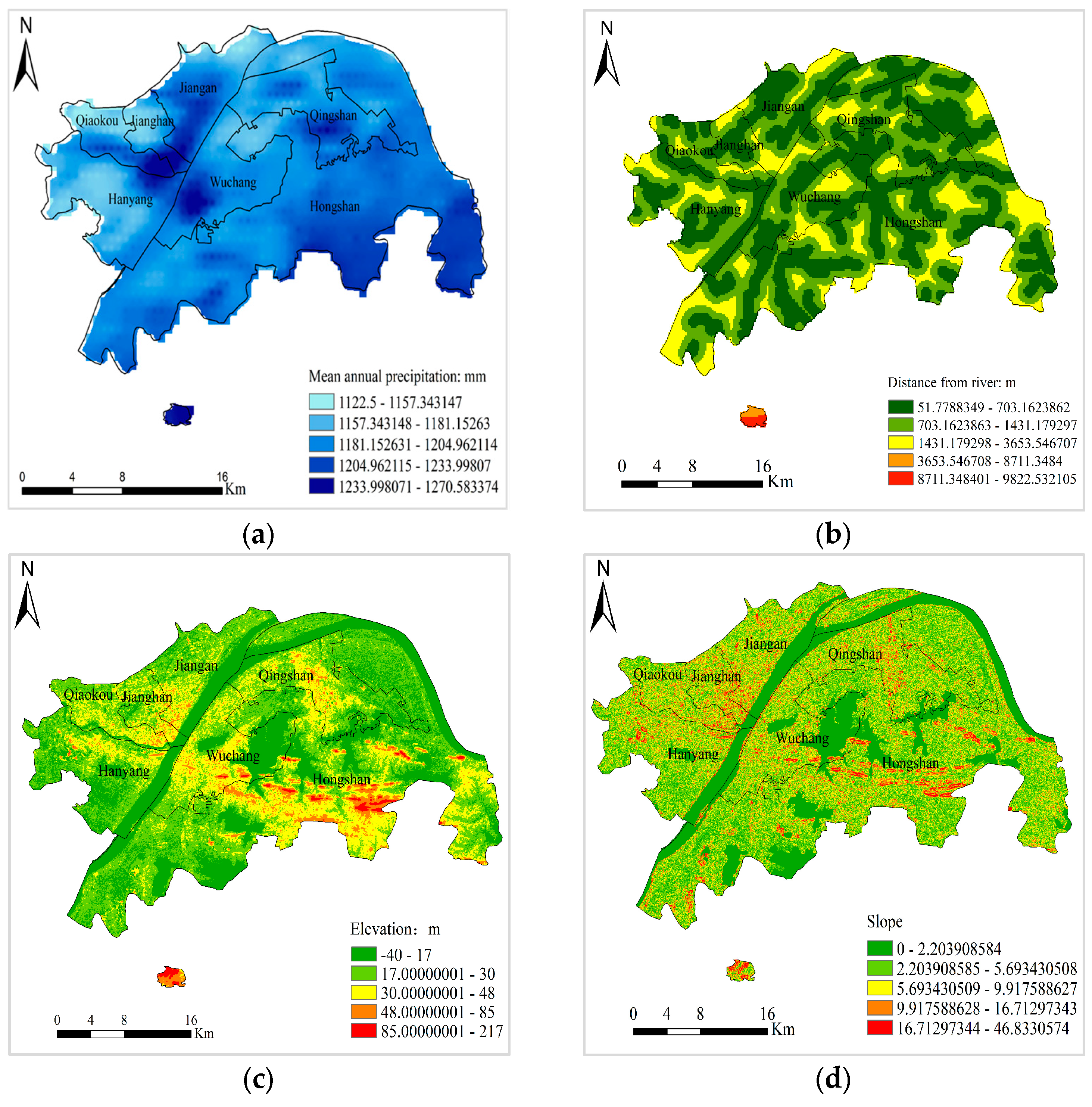
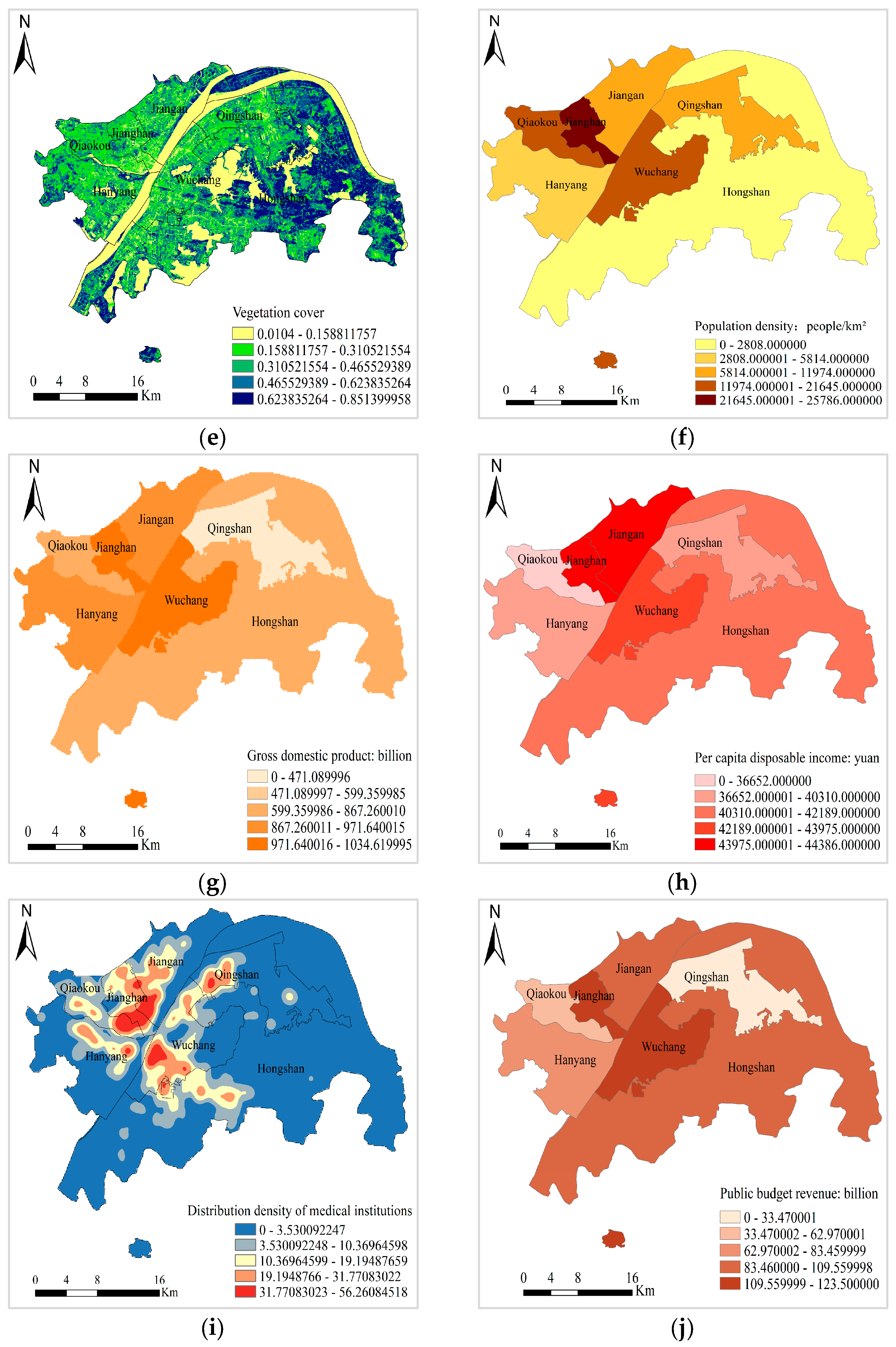
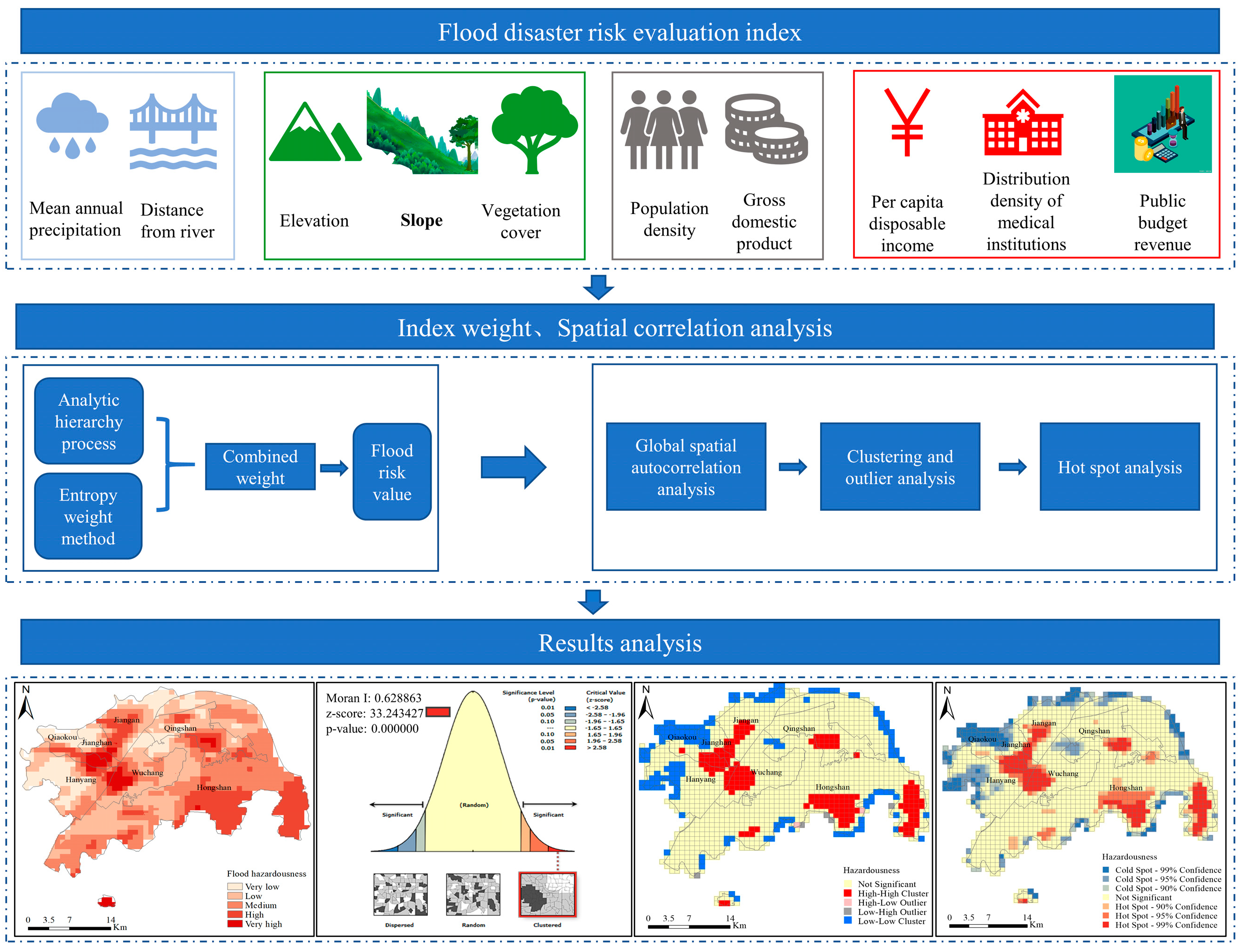
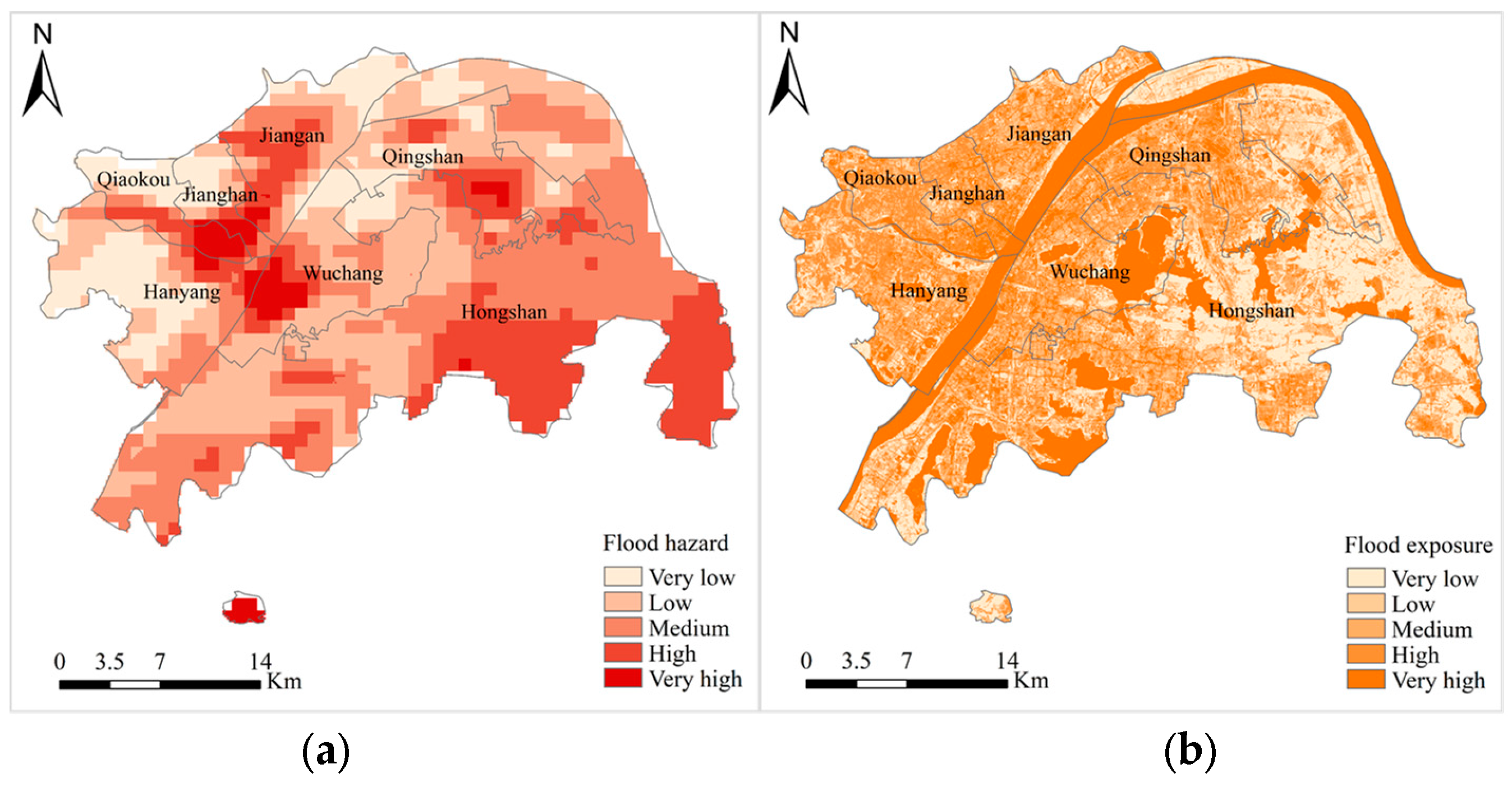
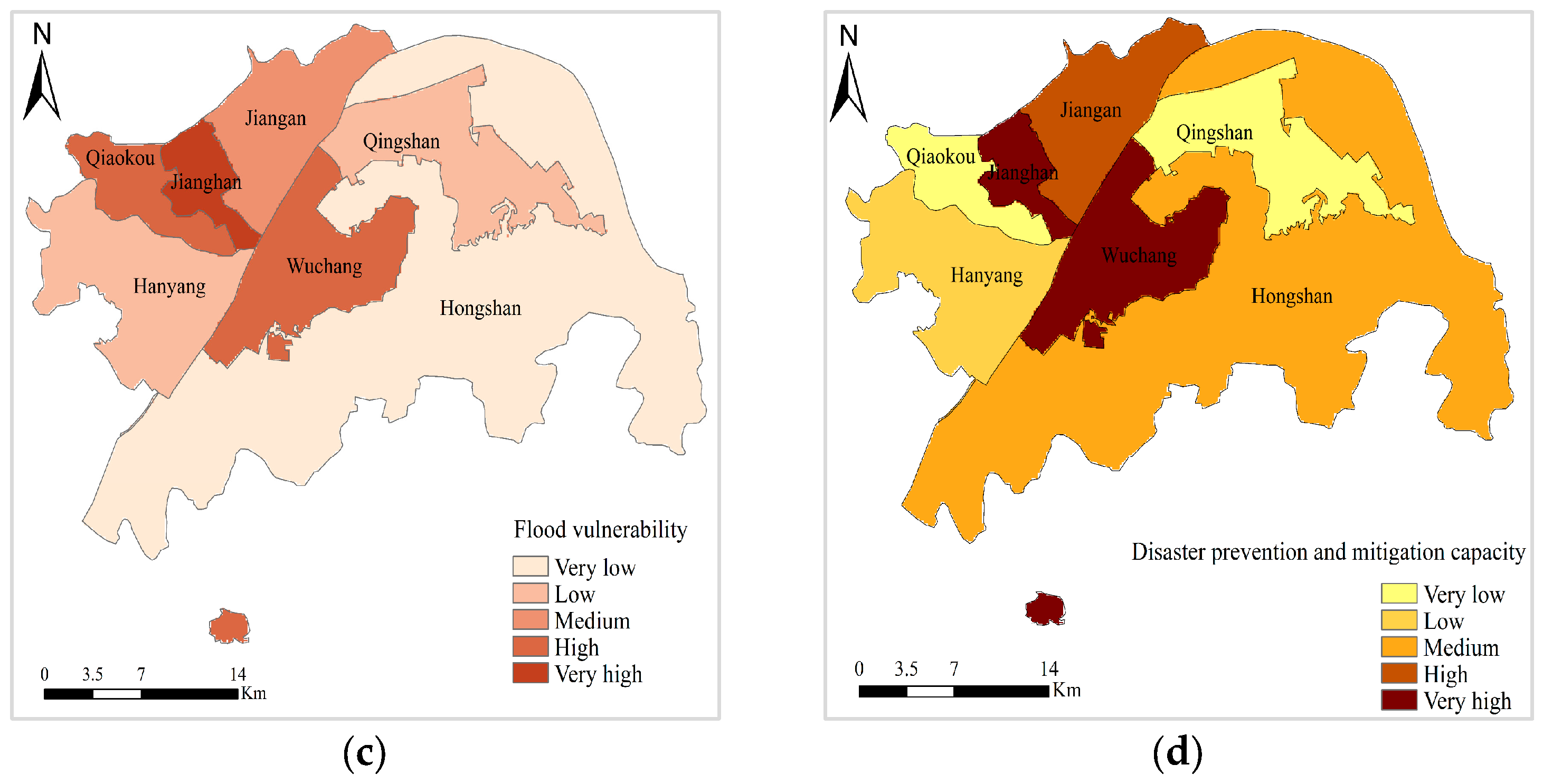
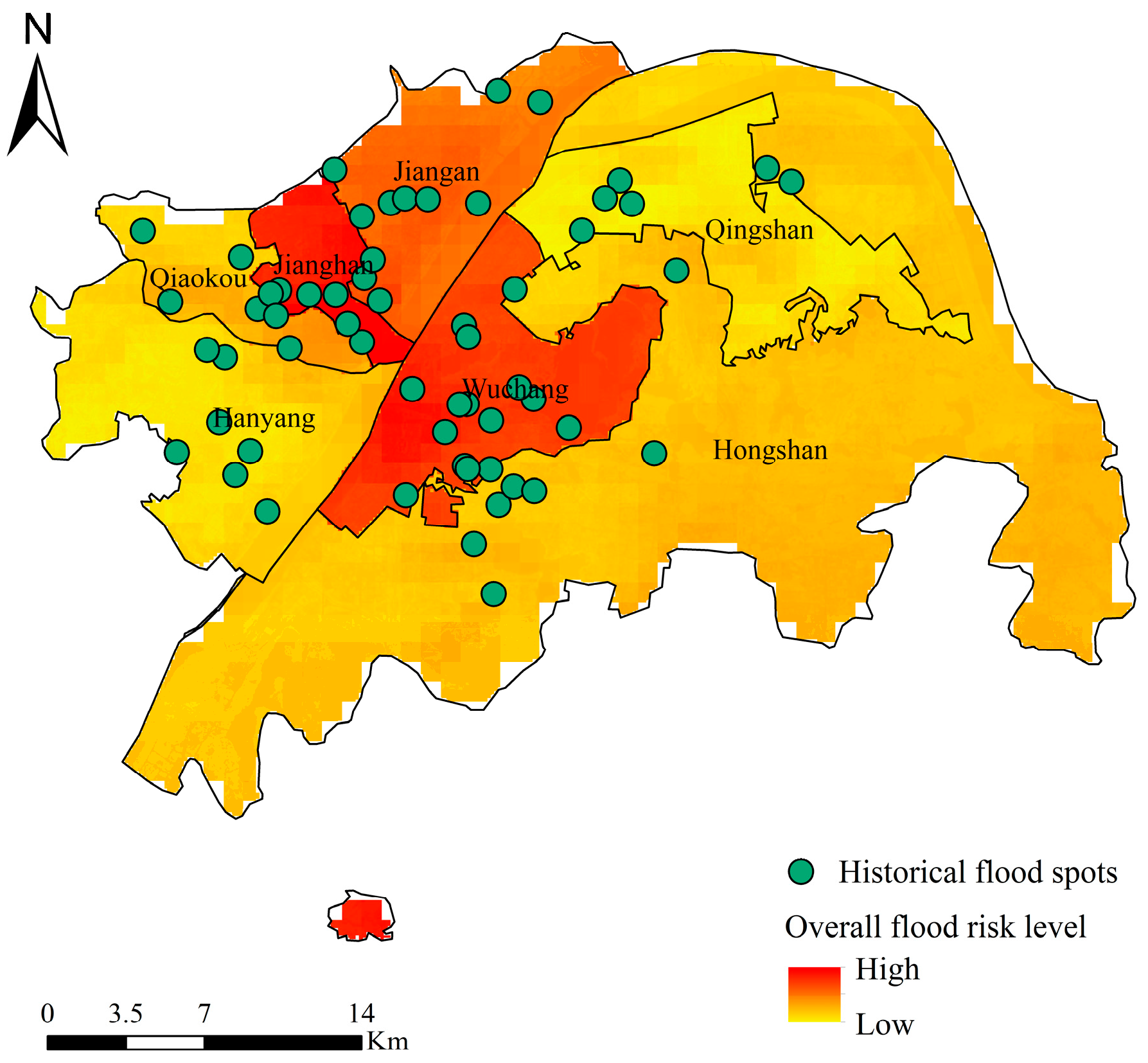
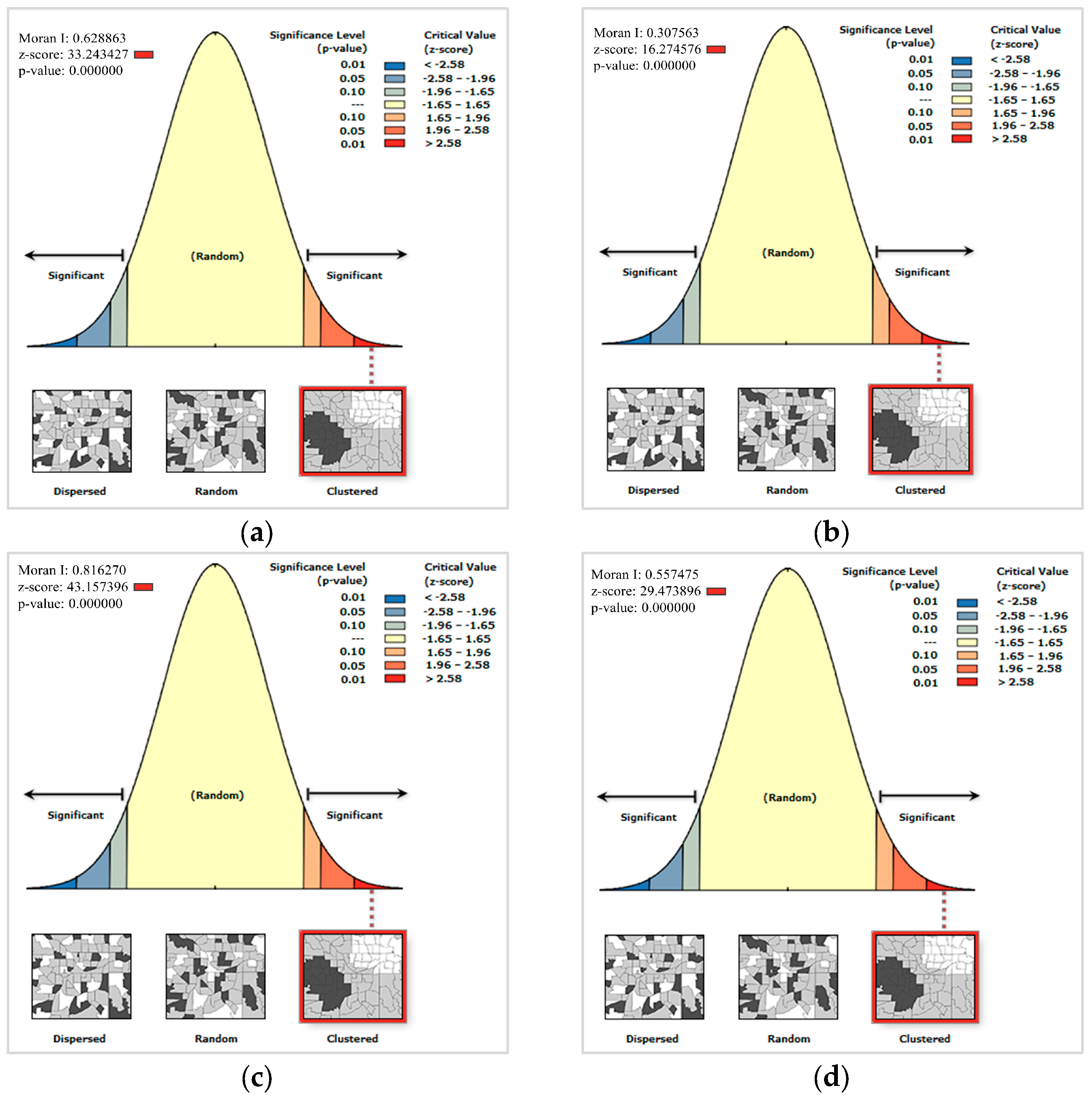
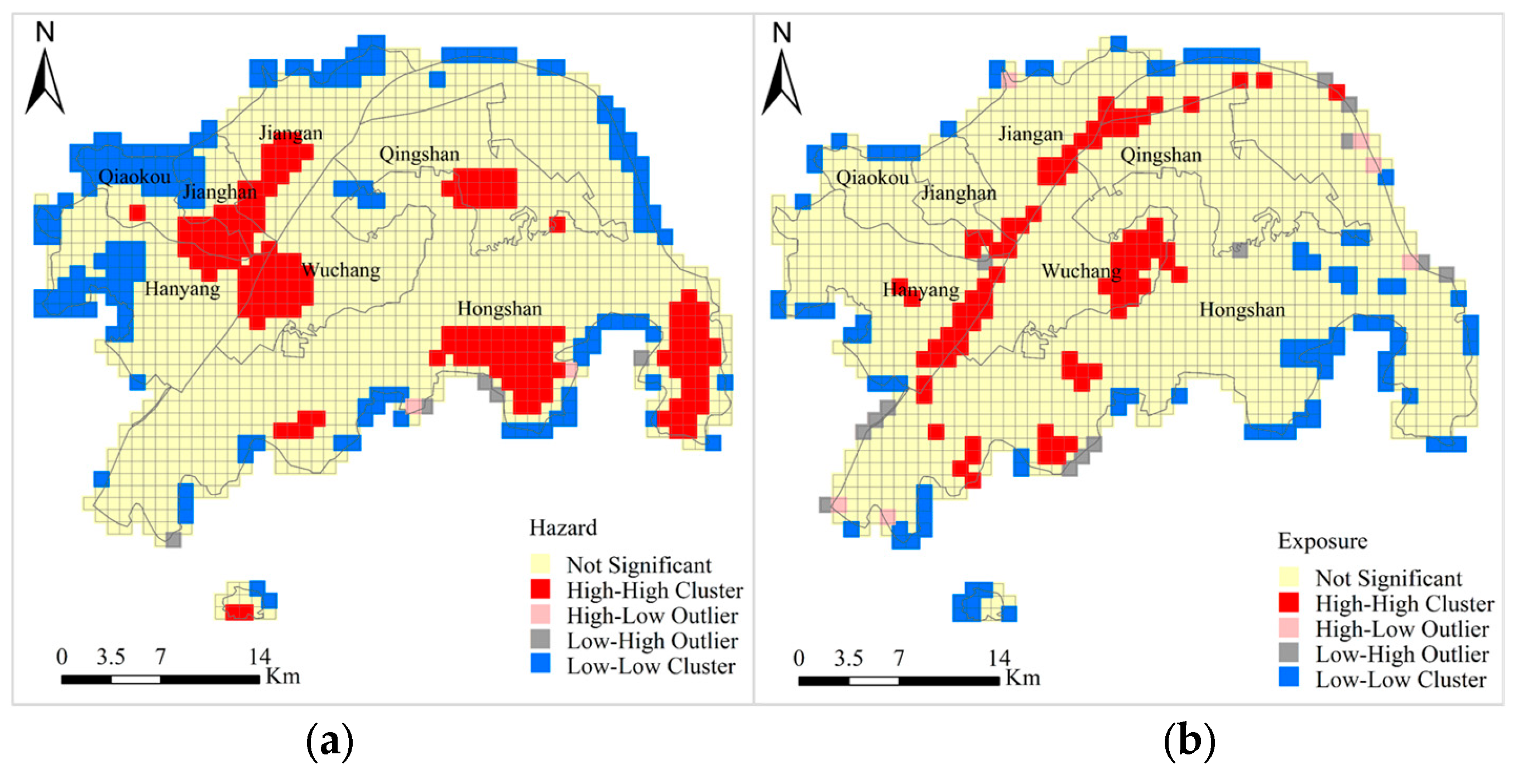
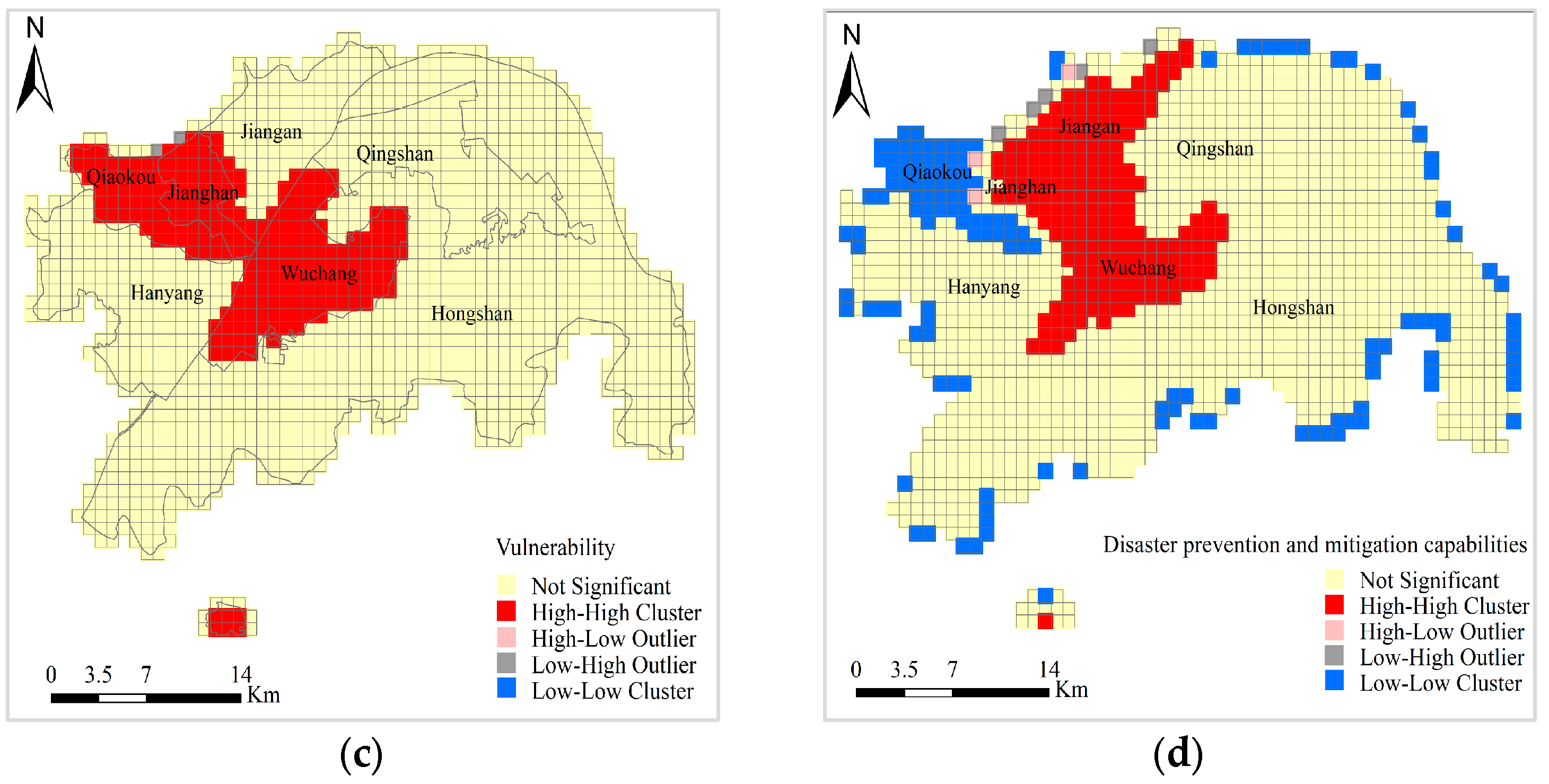
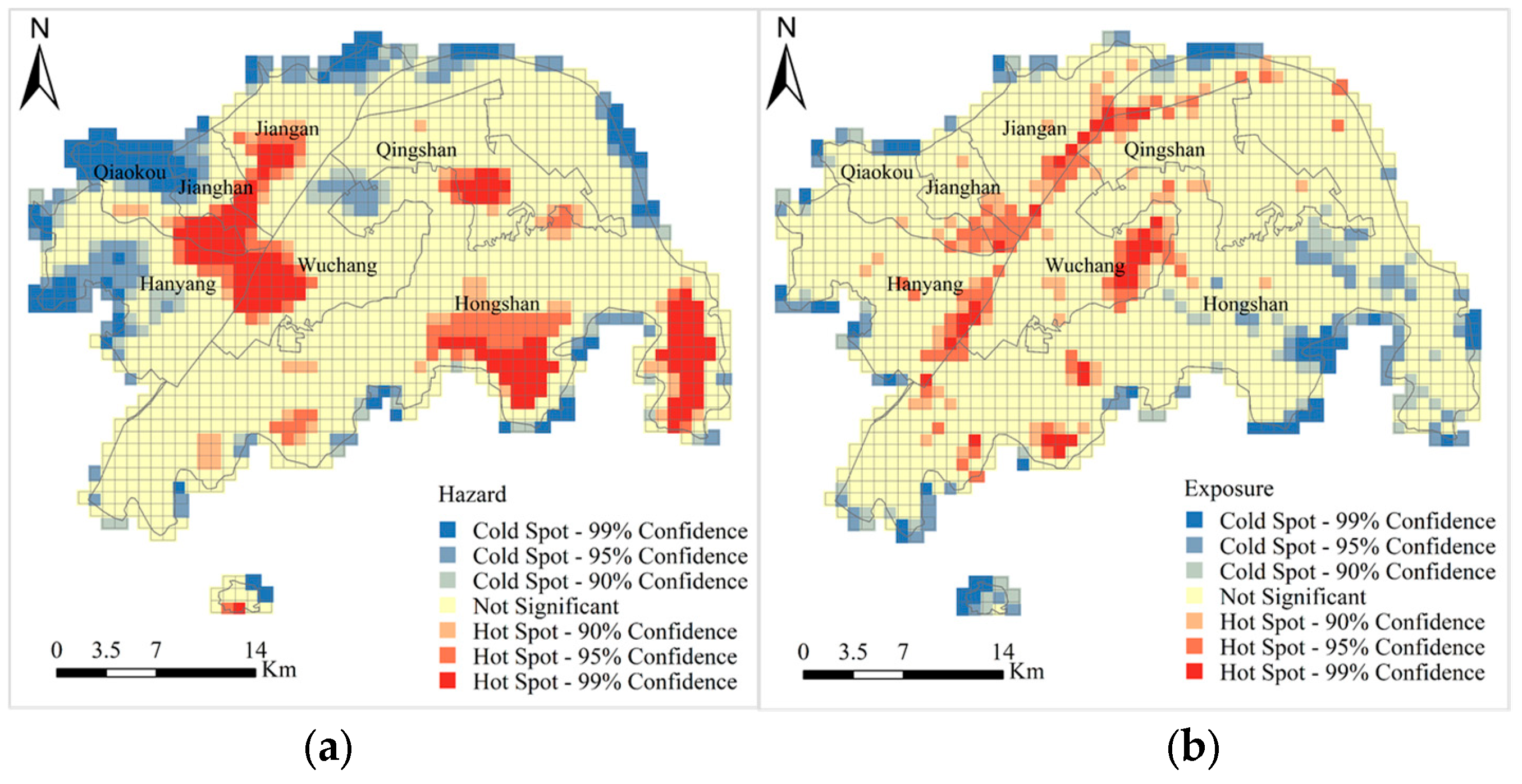
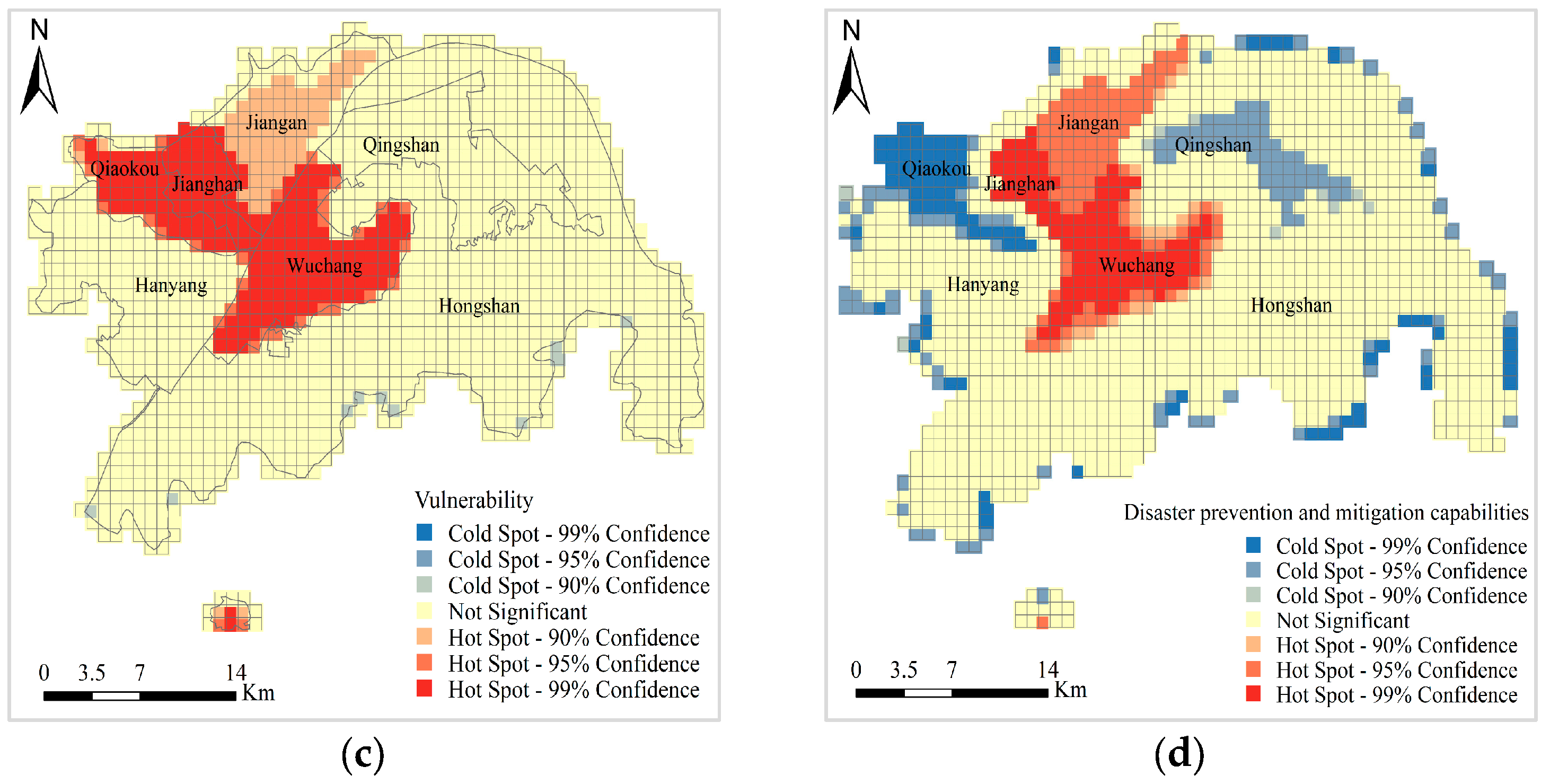
| Indexes | Sub-Indexes | Index Types | Data Source |
|---|---|---|---|
| Hazard | Mean annual precipitation (2016) | Positive | https://loess.geodata.cn/ (accessed on 21 February 2025) |
| Distance from river | Negative | https://loess.geodata.cn/ (accessed on 21 February 2025) | |
| Exposure | Elevation | Negative | https://www.webmap.cn/commres.do?method=dataDownload (accessed on 27 August 2024) |
| Slope | Negative | https://www.webmap.cn/commres.do?method=dataDownload (accessed on 27 August 2024) | |
| Vegetation cover | Negative | https://www.resdc.cn/Datalist1.aspx?FieldTyepID=11,6 (accessed on 3 August 2024) | |
| Vulnerability | Population density (2016) | Positive | https://tjj.wuhan.gov.cn/tjfw/tjnj/ (accessed on 16 December 2024) |
| Gross domestic product (2016) | Positive | https://tjj.wuhan.gov.cn/tjfw/tjnj/ (accessed on 3 August 2024) | |
| disaster prevention and mitigation capability | Per capita disposable income (2016) | Negative | https://tjj.wuhan.gov.cn/tjfw/tjnj/ (accessed on 3 August 2024) |
| Distribution density of medical institutions (2016) | Negative | https://wjw.hubei.gov.cn/ (accessed on 20 August 2024) | |
| Public budget revenue (2016) | Negative | https://tjj.wuhan.gov.cn/tjfw/tjnj/ (accessed on 3 August 2024) |
| Primary Index | Secondary Index | Weight Results of Analytic Hierarchy Process | The Weight Result of Entropy Weight Method | Combined Weight |
|---|---|---|---|---|
| Hazard | Mean annual precipitation (2016) | 0.3279 | 0.0497 | 0.1945 |
| Distance from river | 0.1087 | 0.0027 | 0.0035 | |
| Exposure | Elevation | 0.1036 | 0.0040 | 0.0049 |
| Slope | 0.0698 | 0.0070 | 0.0058 | |
| Vegetation cover | 0.0578 | 0.0577 | 0.0398 | |
| Vulnerability | Population density (2016) | 0.1428 | 0.1990 | 0.3391 |
| Gross domestic product (2016) | 0.0607 | 0.0567 | 0.0411 | |
| prevention and mitigation capability | Per capita disposable income (2016) | 0.0533 | 0.4485 | 0.2852 |
| Distribution density of medical institutions (2016) | 0.0273 | 0.0061 | 0.0020 | |
| Public budget revenue (2016) | 0.0418 | 0.1686 | 0.0841 |
Disclaimer/Publisher’s Note: The statements, opinions and data contained in all publications are solely those of the individual author(s) and contributor(s) and not of MDPI and/or the editor(s). MDPI and/or the editor(s) disclaim responsibility for any injury to people or property resulting from any ideas, methods, instructions or products referred to in the content. |
© 2025 by the authors. Licensee MDPI, Basel, Switzerland. This article is an open access article distributed under the terms and conditions of the Creative Commons Attribution (CC BY) license (https://creativecommons.org/licenses/by/4.0/).
Share and Cite
Jing, W.; Song, Y.; Lv, W.; Yang, J. Risk Assessment of Flood Disasters with Multi-Source Data and Its Spatial Differentiation Characteristics. Sustainability 2025, 17, 7149. https://doi.org/10.3390/su17157149
Jing W, Song Y, Lv W, Yang J. Risk Assessment of Flood Disasters with Multi-Source Data and Its Spatial Differentiation Characteristics. Sustainability. 2025; 17(15):7149. https://doi.org/10.3390/su17157149
Chicago/Turabian StyleJing, Wenxia, Yinghua Song, Wei Lv, and Junyi Yang. 2025. "Risk Assessment of Flood Disasters with Multi-Source Data and Its Spatial Differentiation Characteristics" Sustainability 17, no. 15: 7149. https://doi.org/10.3390/su17157149
APA StyleJing, W., Song, Y., Lv, W., & Yang, J. (2025). Risk Assessment of Flood Disasters with Multi-Source Data and Its Spatial Differentiation Characteristics. Sustainability, 17(15), 7149. https://doi.org/10.3390/su17157149






